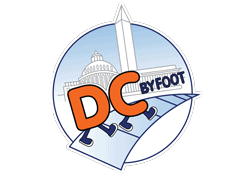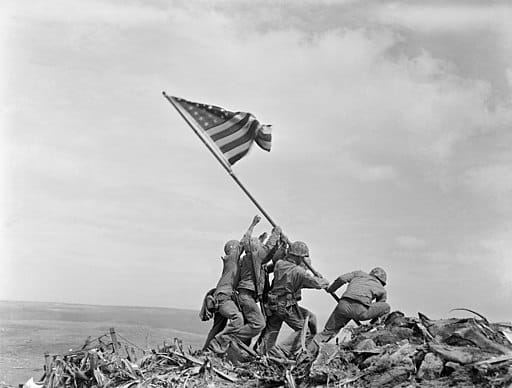This post is a guide to the United States Marine Corps War Memorial (also known as the Iwo Jima Memorial) in Arlington VA, just outside of Washington, DC.
- Introduction
- Plan Your Visit
- Design and Symbolism
- Guided Tours + Talks
- Other DC Memorials
- Things to Do in DC
Overview
The memorial is dedicated to all US Marine Corps veterans who have served and to those who gave their lives since the beginning of the Marine Corps in 1775.
This memorial is often referred to as the Iwo Jima Memorial because it depicts the famous WW2 image for the flag raisers on Iwo Jima Island in the Pacific Ocean.
(We have a section explaining the battle).
It is located in Arlington, VA, just across the Potomac River from the National Mall and just outside of the walls of Arlington National Cemetery.
Although it's not on the National Mall with most of the other memorials, it's absolutely worth the visit. The six figures holding up the flag is an impressive sight and is great to view both during the day and at night.
There is no cost to visit the memorial and no tickets are required.
Read more about the design in the next few sections.
PLAN YOUR VISIT
Due to the memorial's relatively remote location, it's important to plan your visit in order to be as efficient with your time as possible.
Operating Hours
The Iwo Jima Memorial is open from 6:00 am to midnight every day.
The memorial has recently built restroom facilities, along with water fountains, and trash cans nearby.
It is also not far from Arlington National Cemetery, in which there is a visitor center with restrooms.
The Iwo Jima Memorial is a popular memorial to visit at night.
It is lit to make the figures look even more imposing, and is a sight seen as people drive by. Though rangers are not on site all night it is relatively safe.
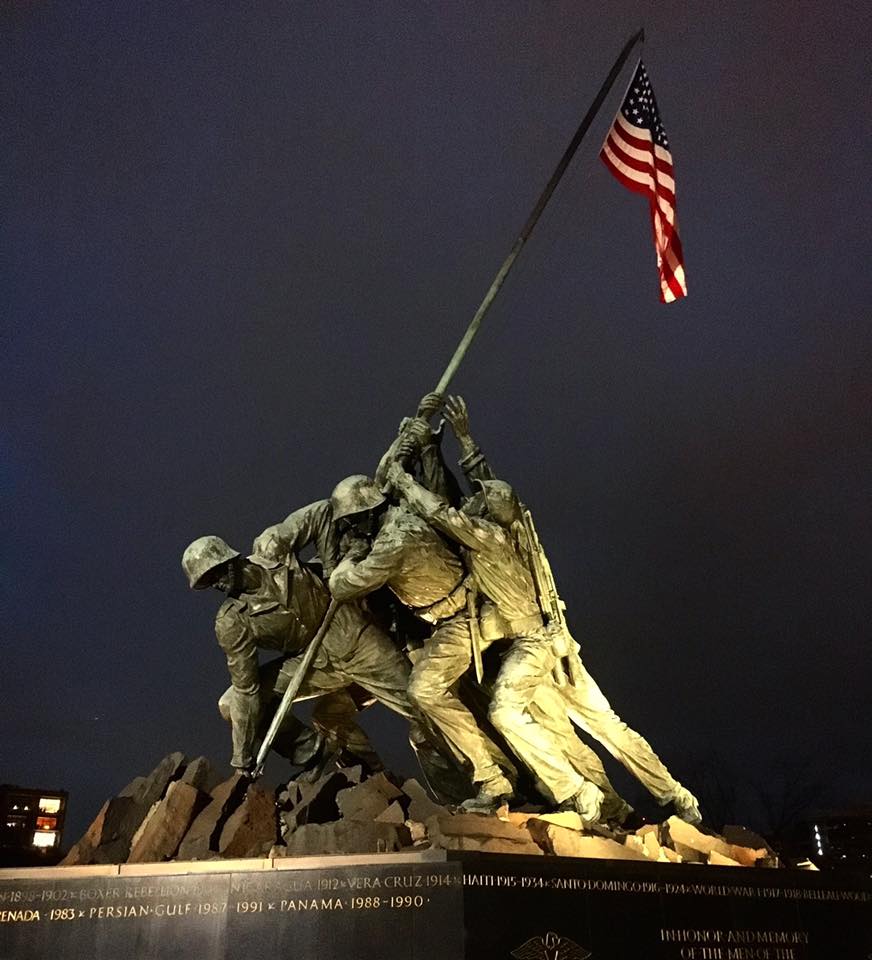
Where Is the Iwo Jima Memorial Located?
The Iwo Jima Memorial is located in Arlington Virginia just to the north of Arlington National Cemetery and across the Potomac River from Washington, DC.
Regardless of how you decide to get here, we recommend using this Google map for directions.
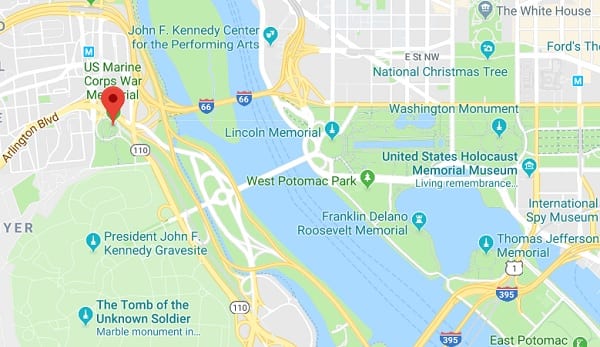
Below are our tips for visiting on your own, whether by car, public transportation, biking or walking.
However, most visitors come via an organized bus tour. Several tours come during the day, but most bus tours visit at night.
Parking
There is limited parking on the memorial grounds (only 6 parking spots). There is additional street parking along North Meade Street and in the neighborhood to its east.
If you are just coming for a quick photo, you should be able to accomplish this by double parking at the bus drop off area (this is technically not allowed).
You can also park at Arlington National Cemetery and then take the 15-minute walk to the memorial (see more below).
Public Transit
The closest Metro station is the Rosslyn Metro Station (Blue/Orange/Silver). It's a 10-minute walk to the memorial.
Head south on Fort Myer Dr. toward Wilson Blvd. Eventually, take a left on Meade Street. You will see the Iwo Jima Memorial on your left.
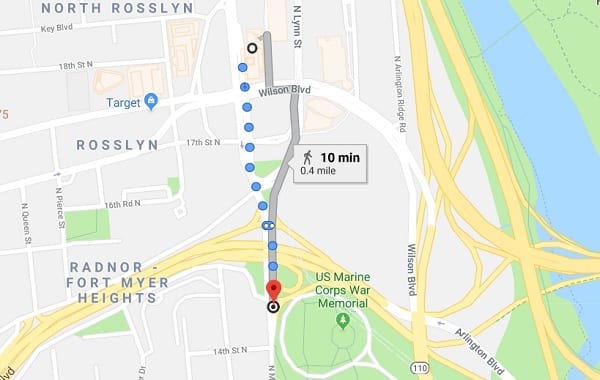
You can also arrive at the Arlington Cemetery Metro Station (Blue line). After exiting the station, walk towards the entrance of the cemetery.
Within 100 yards, you will note a bike path that veers off to the right. Follow that path as it takes you alongside the highway and ends on the outskirts of the cemetery (10 min. walk).
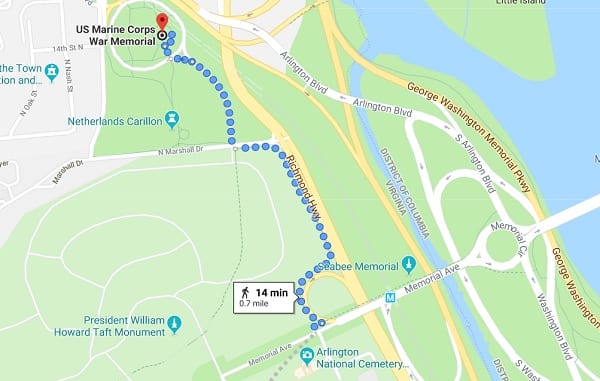
Walk straight over the small grassy hill in front of you, passing the Netherlands Carillon Bell Tower on your left.
The Marines Corps Memorial will be straight ahead (5 min walk).
It can also be accessed from inside Arlington National Cemetery, so for those visiting the cemetery, you can add Iwo Jima as a follow-up to your visit there.
You can exit the cemetery via the Ord-Weitzel Gate on the north side of the cemetery, by Section 27.
If you go this route, you will pass the gravesite of Rene Gagnon, who was initially identified as one of the flag raisers depicted in the famous image. The back of his headstone depicts the flag-raising.
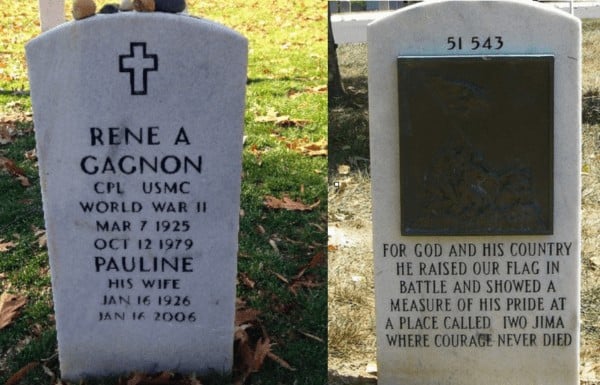
Bike
You can also bike here. There is even a Capital Bikeshare station right next to the memorial.
We have a post with tips on renting a bike in DC.
Nearby Attractions
Due to its location, you might find it beneficial to also plan to visit other memorials that are adjacent or nearby, such as:
Be sure to read our guide to all memorials and monuments in Washington, DC.
Events
During the summer, the US Marine Corps holds Sunset Parades on Tuesday evenings at the memorial.
DESIGN AND SYMBOLISM OF THE MEMORIAL
The Iwo Jima Memorial was dedicated on November 10, 1954, by President Dwight D. Eisenhower.
The design of the memorial was inspired by Joe Rosenthal’s Pulitzer Prize-winning photograph of the raising of the flag on Mount Suribachi during the Battle of Iwo Jima.
There are several design elements to the memorial, so let's get started.
The 6 Statues
The first things that will catch your eyes as you approach the memorial are the six 32 ft (10 m) figures raising a 60 ft (18 m) bronze flagpole.
From the outside in, the figures are Ira Hayes, Harold Schultz (originally identified as John Bradley), Michael Strank, Franklin Sousley, Harold Keller (originally identified as Rene Gagnon), and Harlon Block.
Felix de Weldon, a U.S. Navy Veteran, was hired to sculpt the memorial. He worked directly with the 3 survivors of the assault on Iwo Jima, Bradley, Gagnon, and Hayes, whose faces were modeled in clay.
Though Schultz and Keller both survived the war, neither were correctly identified as being one of the original flag raisers until 2016 and 2019 so they were not part of the process of making the sculpture.
John Bradley was present for the first flag raising (a separate event from this iconic image) which led to the confusion.
Casting the plaster models in bronze took nearly 3 years and a team of highly skilled artisans would be very involved with the construction of the memorial.
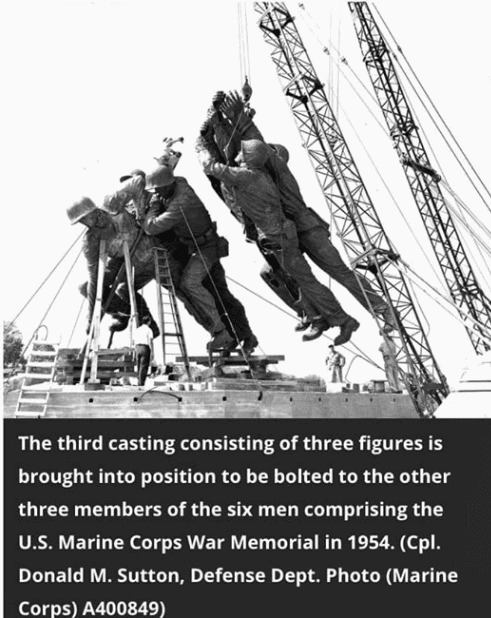
The Flag
The flagpole that the men are raising is 60 ft (18 m) tall and a cast of bronze. The flag at the top flies 24-hours a day.
It is not a federal flag and is not dictated by the President of the United States.
Although there were only 48 stars on the flag when the picture was taken, a modern flag flies with all 50 stars.
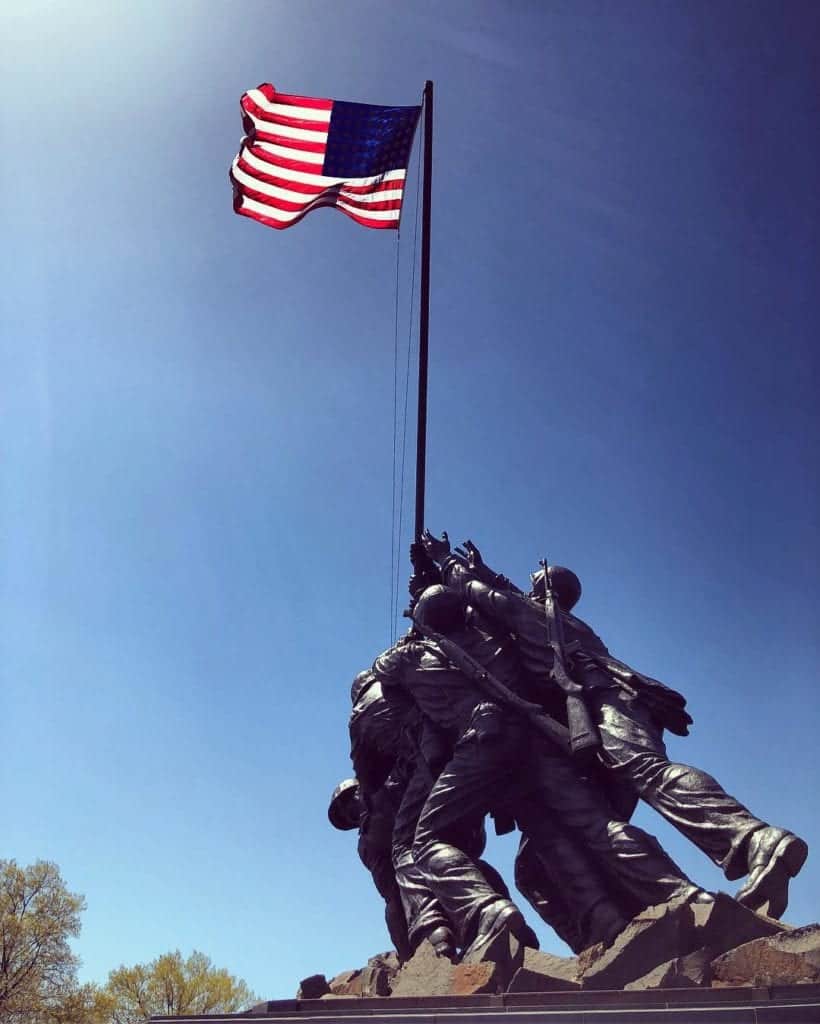
The Base
The base of this memorial is 10 ft (3 m) tall and is made of polished black granite.
Engraved in gold around the base of the memorial are the names of every principal Marine Corps engagement since its founding.
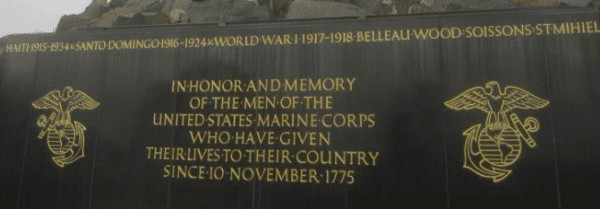
There are also a few inscriptions engraved on the base- on the front (west side) is "Uncommon Valor Was A Common Virtue"
"Semper Fidelis" (Latin for "always faithful") is the motto of the Marine Corps.
On the back (east side) is the inscription "In Honor And Memory Of The Men Of The United States Marine Corps Who Have Given Their Lives To Their Country Since 10 November 1775".
GUIDED TOURS AND RANGER TALKS
Ranger Talks:
While there are no set ranger talks offered, visitors may request a ranger program at the US Marine Corps War Memorial by calling 703‑235-1530.
These talks are free and last generally for 1 hour.
Guided Sightseeing Tours
Due to the memorial's somewhat remote location, it is not included in most tour company itineraries. However, most night bus tours make a stop here.
A few full-service bus companies make stops here on their daytime tours.
We recommend USA Guided Tours, but their competitors are also very good. Read about them here.
As a literal translation, Iwo Jima means “sulfur island”, which really gives the public a sense of the kind of condition these Marines were fighting in.
Between February 19, 1945, and March 16, 1945, over 6,000 American troops would lose their lives. On the fifth day of this gruesome battle, an American flag was raised atop of Mount Suribachi.
This was the first time that the American flag had flown on Japanese soil, marking an incredible turning point in the war.
However, the Pulitzer Prize-winning photo that is now so famous was actually the second flag to be raised that day. Earlier, a much smaller flag had been raised.
However, realizing the significance of the moment and hoping to make the flag visible to nearby landing beaches, it was decided to raise a much larger flag.
Joe Rosenthal, a young amateur photographer, climbed to the top of Mount Suribachi to capture this second flag raising.
The photo featured Michael Strank, Harold Keller (originally identified as Rene Gagnon), Ira Hayes, Franklin Sousley, Harold Schultz (originally identified as John Bradley), and Harlon Block propping up a pole amongst rumble, with the American flag fluttering above.
Following its publication, this image turned up in newspapers across the country. People were drawn into and inspired by this incredibly patriotic photo and thus it was decided to bring these 6 men home.
However, only three of the men believed to have raised the flag at the time (Bradley, Gagnon, and Hayes) would survive the battle.
In 2006, the film Flags of our Fathers was released. Based on a book by the same title, the movie depicts the story of the men who participated in that second raising of the flag and who were made famous by Rosenthal’s photo.
Related Content
